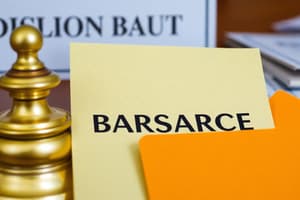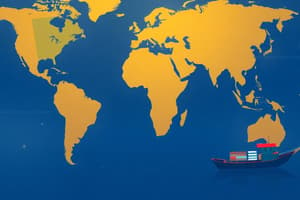Podcast
Questions and Answers
A company in Country A exports a product to Country B, claiming preferential tariff treatment under an existing FTA. During customs clearance in Country B, what documentation is generally required to substantiate this claim?
A company in Country A exports a product to Country B, claiming preferential tariff treatment under an existing FTA. During customs clearance in Country B, what documentation is generally required to substantiate this claim?
- Bill of Lading, Commercial Invoice, and Packing List only.
- Any document that shows the product was shipped directly from Country A to Country B.
- A self-declaration by the importer stating the product meets the FTA's requirements.
- Bill of Lading, Commercial Invoice, Packing List, and a Preferential Certificate of Origin (PCO). (correct)
A manufacturer in Singapore uses non-originating materials to produce goods which are then exported to Australia. Which of the following methods can be used to determine if the goods qualify as originating under the Singapore-Australia FTA?
A manufacturer in Singapore uses non-originating materials to produce goods which are then exported to Australia. Which of the following methods can be used to determine if the goods qualify as originating under the Singapore-Australia FTA?
- Change in Tariff Classification (CTC), Regional Value Content (RVC), or Process Rule. (correct)
- Change in Tariff Classification (CTC) only.
- Regional Value Content (RVC) only.
- Process Rule only.
Why are customs brokerage and trade compliance considered important aspects of international trade?
Why are customs brokerage and trade compliance considered important aspects of international trade?
- They are only required for businesses dealing with restricted goods.
- They solely ensure the payment of correct duties and taxes.
- They are primarily concerned with negotiating better trade deals between countries.
- They facilitate day-to-day trade operations and ensure adherence to trade rules and regulations. (correct)
What happens to tariffs as more nations adhere to the WTO's Most Favored Nation (MFN) principle?
What happens to tariffs as more nations adhere to the WTO's Most Favored Nation (MFN) principle?
What is one key element of trade compliance related to product classification, and what could be a consequence of misclassifying goods?
What is one key element of trade compliance related to product classification, and what could be a consequence of misclassifying goods?
Flashcards
What is a customs broker?
What is a customs broker?
Helps importers/exporters process declarations through customs and border agencies; prepares documents, calculates duties/taxes, arranges inspections, and arranges delivery.
Customs Brokerage Activities
Customs Brokerage Activities
Activities include the preparation of declaration, checking and verification, submission of declaration, payment of import/export duties, inspection and release of cargo.
Customs Brokerage
Customs Brokerage
Day-to-day operational tasks to ensure trade happens smoothly.
Trade Compliance
Trade Compliance
Signup and view all the flashcards
Rules of Origin (ROO)
Rules of Origin (ROO)
Signup and view all the flashcards
Study Notes
- This lecture covers customs brokerage, Free Trade Agreements (FTAs), and trade compliance within intermodal freight transportation and logistics.
Module Overview
- Lecture 7 focuses on customs brokerage processes, the relevance of the World Trade Organization (WTO) and FTAs, and describing FTA processes.
- Lectures 8-10 cover topics, such as the Control Tower, emerging technology, E-commerce logistics, transportation sustainability, international transport risks, and supply chain risks.
- Lectures 11-13 are dedicated to group assignment presentations.
Group Presentation Schedule
- Group presentations will occur, with presentation dates and times given
- Each group is assigned a combination of industry and company across various sectors, such as consumer health, electronics, aerospace, and automotive.
Customs Clearance
- Export customs procedures typically occur before cargo loading.
- Import customs usually happen when the container is at the terminal and ready for consignee pick-up.
- Pre-customs clearance can be arranged depending on the country.
- The customs process involves documentation and potentially physical inspection.
- Customs processes can differ among countries.
Role of a Customs Broker
- Customs brokers assist importers and exporters by processing declarations through customs and associated border agencies.
- Brokers handle required documentation, duty and tax calculations, inspections, and delivery arrangements.
Customs Brokerage Activities
- Activities encompass preparation/submission of declarations, checking/verification, payment of duties, cargo inspection/release, handling formalities, document legalization, compliance assessment, duty/tax programs, diplomatic cargo clearance, and the certificate to release goods.
- Required documents include a draft bill of lading, packing list, commercial invoice, and Certificate of Origin (COO).
- A preferential Certificate of origin (PCO) for FTA duty savings and a license or permit might be needed.
Trade Compliance
- Customs brokerage involves day-to-day activities to ensure trade.
- Trade compliance is vital to ensure that all parties in the supply chain follow trade rules.
- Trade compliance involves HS classification, review of the Denied Party List (DPL), export control, and licensing.
World Trade Organization (WTO)
- The General Agreement on Tariffs and Trade (GATT) was a multilateral agreement with 23 countries in 1947.
- GATT addressed various trade issues and disputes before 1995 and conducted eight negotiation rounds, with the Uruguay Round being the longest.
- The benefits of GATT were significant tariff reduction and world peace.
- On January 1, 1995, the WTO replaced GATT as the trade-governing body.
- GATT remains a cornerstone that provides rules for the WTO.
- The WTO's role expanded beyond trade in goods and includes trade in services, intellectual property, and movement of people.
- WTO is essentially a negotiating forum with a set of rules that helps to settle disputes.
- The WTO framework is based on the General Agreement on Tariffs and Trade (GATT), the General Agreement on Trade in Services (GATS), Trade-Related Aspects of Intellectual Property Rights (TRIPS) and Trade-Related Investment Measures (TRIMS).
Tariffs and Trade Agreements
- Tariffs are at their lowest levels as nations adhere to the WTO's Most Favored Nation (MFN) principle.
- Average tariffs vary across countries.
- There has been growth in preferential trade agreements in the last few decades.
Preferential Trade Agreements
- There are many overlapping trade agreements, creating a 'spaghetti effect', and making customs brokerage and trade compliance more difficult.
- Major regional trade blocs and emerging developments include the European Union, GCC, ASEAN+1 FTA, RCEP, TPP-11 and NAFTA FTA.
- The largest FTA trade bloc by combined GDP is the NAFTA FTA.
- The exercise involves identifying multilateral FTAs and the countries they represent.
Bilateral vs Multilateral FTAs
- Bilateral FTAs: Country-to-country agreements allowing FTA savings for direct shipments with straightforward documentation.
- Multilateral FTAs: Multi-country agreements allowing FTA savings for both direct and regional re-export shipments.
- Documentation involving RDC is more complex, and companies are trying to use these agreements.
Free Trade Agreements (FTAs)
- FTAs cover trade in goods and services, investment protection, intellectual property protection, movement of business persons, mutual recognition of standards and qualifications, and government procurement.
- A crucial benefit of FTAs is the elimination or reduction of import tariffs.
- Tariff savings from FTAs are only achievable if consignment, origin, and documentation requirements are met.
FTA Conditions
- The shipping route needs to conform to FTA consignment requirements
- Products need to satisfy FTA Rules of Origin.
- The product must have been wholly produced, or underwent substantial transformation
- Products must meet HS code specifications.
- Required documentation that should be presented include the Preferential Certificate of Origin (PCO), bill of lading, commercial invoice, and packing list.
Import Duty Savings Example
- An example is provided for import duty savings for apparel machinery parts manufactured in Singapore and exported to Australia, comparing the MFN rate and preferential rates under the Singapore-Australia FTA and the ASEAN-Australia-New Zealand FTA.
- The MFN rate is applied consistently to all WTO member nations.
Rules of Origin
- Preferential certification of origin (PCO) is applied at the manufacturing country.
- Manufacturers need to submit cost statements as proof that a product is eligible to receive PCO
- Rules of Origin (ROO) are used to evaluate product eligibility, under: Wholly Obtained, change in Tariff Classification, Regional Value Content, and Process Rule.
- The PCO is submitted along with the bill of lading (BL) and commercial invoice (CI) to be assessed for FTA duties at the point of inbound customs.
Originating Goods
- Rules of Origin (ROOs) help determine the "nationality" of a good and its eligibility for preferential treatment under an FTA.
- Goods satisfying ROOs under an FTA can pay lower or no import tariffs.
- ROOs vary from one FTA to another.
- An originating good in an exporting Party can be classified under one of two categories: Wholly Obtained (WO) or a good manufactured using non-originating materials.
- A good considered Wholly Obtained (WO) occurs naturally, is harvested, or is an animal that is born and raised.
- Examples of wholly obtained goods are waste derived from production in the country of export, or plastic bottles in Singapore that have also been collected there.
- Goods using non-originating materials will have to undergo substantial transformation.
- Methods to measure the transformation change are: Change in Tariff Classification (CTC), Regional Value Content (RVC), and Process rule.
- These methods can be used in combination or standalone, depending on the origin criteria for the good in a Free Trade Agreement (FTA).
- Origin of these goods depends on the country where the last substantial transformation is performed.
Change in Tariff Classification (CTC)
- The CTC method applies only to non-originating materials.
- Non-originating materials used to produce a good cannot have the same HS classification as the final product to qualify.
- Depending on FTA requirements, a change in chapter, heading, or subheading is required to qualify for preferential treatment.
- Manufacturers and exporters need to know the HS classification of the final good and the non-originating raw materials.
Harmonized Codes
- There are many Harmonized Tariff Schedule (HTS) codes to choose from.
- Duty rates may differ on these codes.
- Fleeces for example may or may not be considered a knitted material, which may lead to appeals for reclassification and a push for lower duty rates.
Regional Value Content (RVC)
- Regional Value Content (RVC) requires that a certain minimum percentage of the good's value originates in a party.
- This party is defined in the Free Trade Agreement (FTA) for the good to be considered as originating.
- The calculation includes the FOB value, the value of non-originating materials.
Process Rule Method
- The Process Rule Method is generally applicable for chemical goods.
- Goods will be considered as originating if it is produced through a specific chemical process that occurred in a Party to the Free Trade Agreement.
Trade Compliance
- Trade compliance is operating within global regulations for trading activities, imports, and exports.
- It means complying with international export, trade, and financial laws.
- It's a responsibility for all businesses, especially those importing and exporting.
- The larger the business, the higher the compliance expectations.
Key Elements of Trade Compliance
- Tariff Classifications, Preferential Origin, Incoterms, Licenses and permits, Export controls, Screening, Customs management, Valuation
Key Elements of Trade Compliance - Tariff classification
- Correct classification using commodity and tariff codes is fundamental and helps establish duty rates, origin of goods, export controls, and other customs procedures.
- Wrong classifications, can lead to red flags raised by customs authorities.
- Tariff classification errors can lead to fines, penalties, and incorrect payments of customs duty.
- This is an area where companies "do not rely on your broker to get the tariff classification right".
Key Elements of Trade Compliance - Preferential Origin
- Preferential origin involves a specific trade agreement between countries.
- If goods are of preferential origin, they get reduced duty rates upon entry to the customer's country.
- The exporter is responsible for following rules of preferential origin to the letter.
- A failure to process data and paperwork could lead to 3 years' worth of unpaid duties, a liability.
- If goods are classified as "Non-preferential origin", it dictates what country the product was shipped from and the rules associated with it.
- Errors can lead to the product's origin being declared incorrectly, and lead to fines and penalties.
Key Elements of Trade Compliance -Incoterms
- Incoterms are trade terms used to clarify buyer and seller responsibilities during the shipment lifecycle
- The 2 main things they clarify are (1) delivery and (2) costs, risks and responsibilities.
- Incoterms should be established, read, and applied across import and export to reduce risk of misunderstanding
- Errors in incoterms can lead to overpayment and confusion within the supply chain.
Key Elements of Trade Compliance - Licenses and permits
- When importing or exporting certain products, it needs to be checked as to whether a license or permit is required
- Specific controls exist for military/paramilitary goods, technology, medicines, chemicals, artworks, plants and animals.
- Exporting and importing without the right license could be a criminal offense, lead to delays and possible confiscation.
- A key to staying compliant is to establish specific license management controls.
Key Elements of Trade Compliance - Export controls
- Certain products and underlying tech may be subject to export control.
- Export control legislation is for the classification of all products against the appropriate legislation (to ensure the right license requirements are established).
- Different controls apply to goods under ITAR (International Traffic in Arms Regulations) or EAR (Export Administration Regulations).
- If this compliance is not followed, substantial fines and imprisonment may occur.
Key Elements of Trade Compliance - Screening
- Screening customers, vendors, and transaction data against sanctioned entities will help ensure one is not inadvertently doing business with an undesirable person or party.
- Companies should compare all data against external lists from entities, such as the Office of Foreign Assets Control and the United Nations.
- Screening should occur not only at the start of a relationship, but daily and when dealing with transactions.
- Sanction breaches are criminal offences that can lead to fines, and imprisonment.
Key Elements of Trade Compliance - Customs management
- Customs management focuses on a quick and smooth resolution to trade compliance issues.
- Effective relationship with a broker is very important, if your business happens to be the subject of a customs investigation
Key Elements of Trade Compliance - Valuation
- It's important to establish a value for imported goods in order to calculate customs duty, import VAT and trade statistics.
- Every shipment has to have the appropriate value associated with it for scrutiny.
- Valuation must comply to the methodologies approved by the World Trade Organisation (WTO) and Single Administrative Document (SAD or form C88).
- Errors can lead to fines, penalties, under/over payment of duties and lead to challenges from custom authorities.
Studying That Suits You
Use AI to generate personalized quizzes and flashcards to suit your learning preferences.




